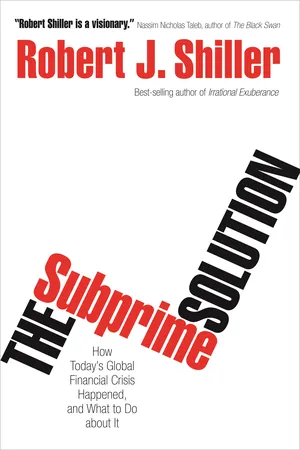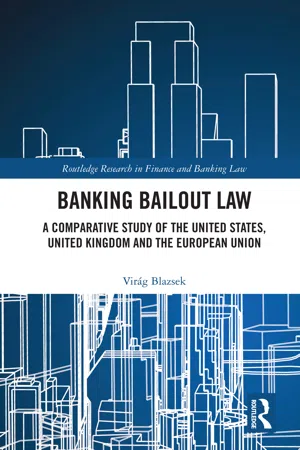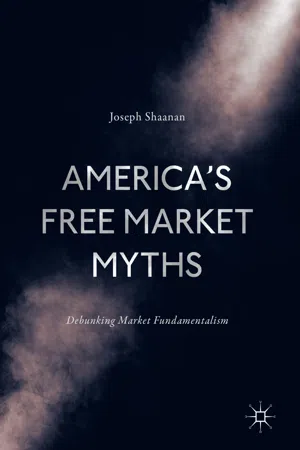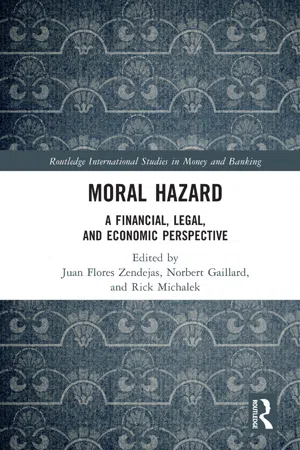Economics
Bailout
A bailout refers to financial assistance provided by a government or other organization to a struggling company or economy. This assistance is typically in the form of loans, grants, or other financial support to prevent the collapse of the entity in question. Bailouts are often controversial, as they involve using public funds to support private entities and can have significant economic and political implications.
Written by Perlego with AI-assistance
Related key terms
1 of 5
7 Key excerpts on "Bailout"
- eBook - ePub
The Subprime Solution
How Today's Global Financial Crisis Happened, and What to Do about It
- Robert J. Shiller(Author)
- 2012(Publication Date)
- Princeton University Press(Publisher)
A Bailout by Any Other Name5Virtually all the solutions to the subprime crisis already tried or already proposed in the United States have aspects of a Bailout to them. This is true of the interest rate cuts by the Fed; the Fed's lending to troubled institutions under the auspices of the TAF, the TSLF, and the PDCF; the tax rebate checks mailed out to individuals; the extension of loan limits by the FHA; and the extension of mortgage ceilings by the government-sponsored enterprises Fannie Mae and Freddie Mac.Let us be clear about what the word Bailout means. Actually the term has only recently acquired prominence, and the word itself is not yet even listed in the Oxford English Dictionary. A Bailout is a rescue by the government or another entity of an irresponsible person or entity arising from a failure to follow rules or take reasonable precautionary steps. In the popular use of the term, a parent who offers a late-night meal to a child who refused to sit down at the family dinner, and is now whining about being hungry, is offering a Bailout.The earliest use I could find of the word Bailout in this sense, from a computer search of English-language newspapers, was in 1950, in the context of criticizing the activities of the Reconstruction Finance Corporation, established during the Great Depression to rescue failing companies by lending them money. Prior to that, the term appears to have been used exclusively to refer to the act of a pilot parachuting from an airplane in trouble.Of course, any postcontract government action that invalidates a prior contract or expectation will be called unfair by some. In the nineteenth century the preferred expressions were the “sponge of insolvency” or “premium on hazard and overtrading.” But the term Bailout - eBook - ePub
Banking Bailout Law
A Comparative Study of the United States, United Kingdom and the European Union
- Virág Blazsek(Author)
- 2020(Publication Date)
- Routledge(Publisher)
Part 2 The current legal–regulatory framework of bank Bailouts 2.1 Introduction Bank Bailouts are highly debated. These measures constitute economic protectionism and systemic corrections. They are by no means phenomena that are only pertinent to market economies. As was discussed in Part 1, in the case of close ties between the state and the financial sector (for example, in China, where there is central planning of the economy) bank Bailouts may also become unavoidable. However, the question can be raised of whether Bailouts are compatible with a free market economy. Currently, there is a majoritarian consensus among scholars that Bailouts are necessary in case of cyclic, systemic failure. 1 The main justification of bank Bailouts is based on ‘systemic stability.’ As was concluded in Part 1, this book supports the opinion that the survival instinct of the government overtakes considerations of economic efficiency in times of financial crisis. The lobbying of financial institutions over politics is an important aspect when analyzing bank Bailout cases, but most Bailouts were initiated by governments worrying about the financial system or the numerous counterparties of failing banks. 2 Bank resolution methods are specific insolvency procedures for failing banks that are designed primarily for business-as-usual times. 3 Bank resolution is not necessarily an alternative to bank Bailouts, as the essence of bank Bailout is to respond to extraordinary crisis circumstances in order to avoid the financial collapse. In contrast, in the case of regular bank-specific insolvency proceedings the entity gets liquidated at the end of the procedure (although restructuring and survival of a ‘residual bank’ is also possible) - eBook - PDF
America's Free Market Myths
Debunking Market Fundamentalism
- Joseph Shaanan(Author)
- 2017(Publication Date)
- Palgrave Macmillan(Publisher)
18 However, the Bailouts did little to correct them and, importantly, were never intended to do so. Did the financial sector need government intervention? Some intervention MYTH 13: THE BailoutS’ PURPOSE WAS TO SAVE THE FREE MARKET 243 probably was necessary. Did it have to be in the form of massive Bailouts with little accountability? No, absolutely not. It was claimed that the huge Bailouts undertaken would solve the financial crisis and its alleged problem – the lack of credit – and prevent a severe economic downturn. However, another objective was the rescue of large financial institutions from failure and providing protection for their top managers and creditors. The power elite were basically shielding fellow club members. During the Crash the Federal Reserve increased liquidity in the financial system to the point that its balance sheet more than doubled in a matter of a few months. 19 More generally, America’s government intervened massively. No amount of money was considered too much and no Bailout plan was regarded too outrageous or too opaque. Every type of help conceivable was used to save these companies and their man- agers and overturn the market’s verdict. Dictionaries had to be modified to account for the new meaning given to words like “socialize”, “status quo protection” and “reverse Robin Hood” actions. Under the guise of the national interest the government used its financial arsenal to rescue giant financial organiza- tions. They had got into trouble by throwing caution to the wind and engaging in large scale speculation. Yet they were deemed too big and too powerful to be allowed to fail. The government seemed determined to preserve the status quo. There was little hesitation in sacrificing economic efficiency, the usual criterion of economic activity. Free market ideology, to which several administrations professed loyalty, was dis- carded, and of course – so was fairness. - eBook - PDF
- Greg N Gregoriou(Author)
- 2009(Publication Date)
- CRC Press(Publisher)
(Bastiat, 1968: 21) He recommends abolishing such laws immediately, before they can multiply and grow into a system. That would be diffi cult to do in the twenty-first century America, since the system of redistribution is firmly established in both Washington and most of the states. But basically the Bailout is nothing more than a redistribution scheme. Money is being transferred from the general population to a special interest group—bankers. Supposedly, the money will trickle down to the people who gave it, but if that were really the case there would be no need to give the money in the first place, since the ultimate recipients—the general citizenry—already have that money in their pockets. 29.5 CONCLUDING COMMENTS Bailing out banks does not pass either the utilitarian ethics test or the property rights test. Sucking money out of the relatively productive sec-tors of the economy to subsidize failed banks results in a negative-sum game because one must take funds out of the more effi cient sectors of the economy before they can be invested in the less-productive sectors. Furthermore, subsidizing failed banks sends the wrong signal. It is a basic law of economics that if you subsidize something you will get more of it. If banks or other industries think the government will bail them out if they fail they will be encouraged to engage in risky activities. An economist would say that the profits are privatized and the losses are socialized. Bailing out any industry causes what economists call a moral hazard. Several studies have applied the concept of moral hazard to the bank Bailout (Anonymous, 2004; Lee and Shin, 2008). Studies suggest that bailing out the financial sector when they make risky investments will lead to more risky investments (Dell’Ariccia et al., 2006). - eBook - PDF
Unsettled Account
The Evolution of Banking in the Industrialized World since 1800
- Richard S. Grossman(Author)
- 2010(Publication Date)
- Princeton University Press(Publisher)
Crises can be alleviated in several ways. First, the bank can acquire more capital, as investors put up cash in return for an equity stake in the institution. Second, the bank can solicit loans of liquid reserves, which can be either unsecured or secured by some of its earning assets. Alter-natively, instead of trying to borrow against its earning assets, the bank can try to sell them. If there is a widespread sale of such assets, then their value—to sell or as collateral—will fall, reducing their ability to alleviate the liquidity shortage. Assistance can also take the form of a variety of measures to stem the outflow of demand liabilities, including restricting deposit withdrawals or providing a guarantee to depositors. The subsequent sections of this chapter consider three main types of rescues: rescues of individual firms, which I term “Bailouts”; assistance to the market, or “lender of last resort operations”; and direct government intervention in the banking system, or “more extreme measures.” Bailouts The most straightforward type of rescue is a Bailout, in which the rescu-ing institution offers assistance directly to one or more ailing firms. The assistance can be via loans or a purchase of shares of the troubled insti- Rescuing the Banking System • 87 tution (Okazaki and Sawada 2007). The assistance is targeted at a lim-ited number of banks, not necessarily any and all troubled institutions. Bailouts raise two immediate questions. First, under what circumstances should a rescue be undertaken? Put more simply, given that bailing out a firm is an option, how should the “to bail, or not to bail” question be answered? Second, who is responsible for undertaking such a rescue? Given that failures of large, important banks are more likely to spread to other institutions through domino and contagion effects, it is not sur-prising that these banks have the highest likelihood of being bailed out. - eBook - PDF
- Patrick S. Kenadjian(Author)
- 2013(Publication Date)
- De Gruyter(Publisher)
The opinions expressed here are those of the author and do not necessarily represent the position of Ernst & Young. 1 As Tucker (2012) writes “if the risk of banking is not incorporated into the yields of bonds is- sued by the banks themselves, then it will be reflected in higher sovereign borrowing costs.” In this regard Ireland is Exhibit A. In 2008 it bailed out its banks by guaranteeing banks’ liabilities (including bonds issued by the banks). This caused the government budget deficit to soar and sovereign debt to rise to the point where Ireland had to seek restructuring assistance from the EU and the IMF. 2 FSB 2011a 168 Thomas F. Huertas disruption to the financial system.3 In October 2011 the Financial Stability Board set out the key attributes for such a resolution framework. This included a rec- ommendation that countries establish special resolution regimes for banks and that such resolution regimes include bail-in as one of the stabilisation options available to the resolution authority.4 The EU Commission has followed the rec- ommendation of the FSB, and its proposed Crisis Management Directive (EC 2012) has included bail-in as one of the tools that resolution authorities should have at their disposal, so that investors, not taxpayers, can pay for bank failures. In the United States, the FDIC is developing proposals for resolution under its Orderly Liquidation Authority that envision what amounts to bail-in of investors at a bank’s parent holding company (Gruenberg, 2012). Bail-ins are superior to liquidation Bankruptcy doesn’t work for banks. The very essence of banking is making com- mitments to pay – depositors at maturity, sellers of securities due to settle, bor- rowers who wish to draw on lending commitments, derivative counterparties who contracted with the financial institution for protection from interest rate, exchange rate or credit risks. - eBook - ePub
Moral Hazard
A Financial, Legal, and Economic Perspective
- Juan Flores Zendejas, Norbert Gaillard, Rick Michalek, Juan Flores Zendejas, Norbert Gaillard, Rick J. Michalek, Rick Michalek, Juan Flores Zendejas, Norbert Gaillard, Rick J. Michalek(Authors)
- 2021(Publication Date)
- Routledge(Publisher)
emergency policies could be regarded as a new paradigm. This is not our view. We argue that the Bailouts of the 1970s are the perpetuation and the predictable application of so-called Keynesian measures. These Bailouts may have taken a novel form due to an unstable international economy, but they were primarily designed to ensure a high, if not the maximum, level of GDP growth.These Bailouts were more frequent, more costly, and increasingly took the form of discretionary programs. In fact, what evolved most significantly were the interest groups that took advantage of these ad hoc measures. At the very beginning of this third period under consideration, industrial firms absorbed the benefit of these rescue packages. Later, the Bailouts were driven by a concern for systemic risk to the banking system, a pillar of the U.S. hegemony in the international economy. The apparent success of the financial Bailouts accelerated the financialization of the economy and encouraged neoliberal policies.The conclusion we can draw is that the institutionalization of Bailouts is “ideology-free”: it is fundamentally disconnected from either the Keynesian or neoliberal dogma. Rather, it quickly became a pure policy tool that tends to favor the most established and influential pressure groups at a given time (Lowi, 1979 ). Considering the evolution of the U.S. economic and financial landscape in the early 1980s, it is not surprising that such institutionalization paved the way for the creation and emergence of mega-banks exploiting morally hazardous strategies. The remainder of this chapter follows both a chronological and analytical order.During 1970–1973, the Nixon administration intervened extensively to support economic activity. It pressured the Federal Reserve to lower interest rates while the FDIC rescued several distressed banks. Despite that overt pressure, the Bailout of defense giant Lockheed in 1971 was passed in the Congress by a very narrow margin, reflecting the growing concern from many policymakers and economists reluctant to use taxpayer funds to bail out private entities (Section 1
Index pages curate the most relevant extracts from our library of academic textbooks. They’ve been created using an in-house natural language model (NLM), each adding context and meaning to key research topics.






